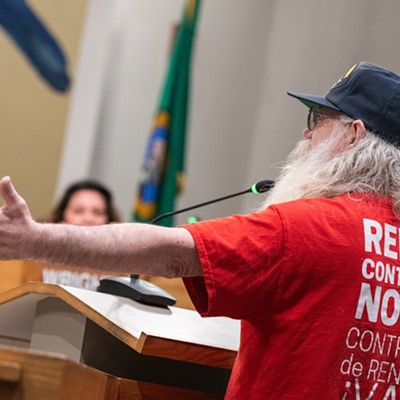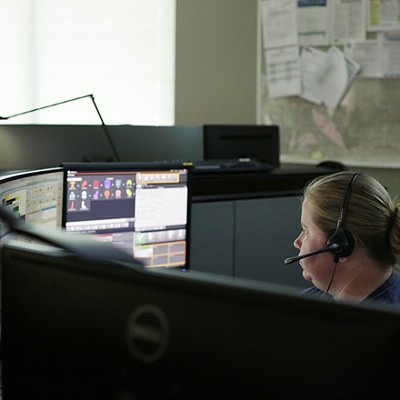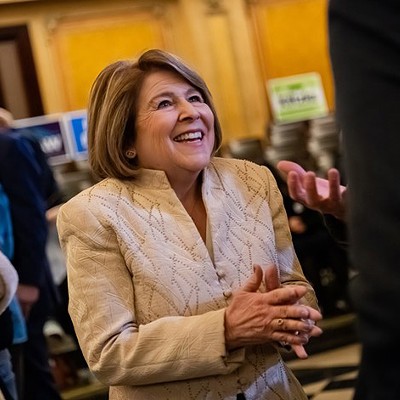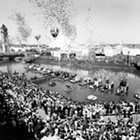Women with wings
[
{
"name": "Broadstreet - Instory",
"component": "25846487",
"insertPoint": "4",
"requiredCountToDisplay": "4"
},{
"name": "Broadstreet - Empower Local",
"component": "27852456",
"insertPoint": "8",
"requiredCountToDisplay": "8"
},{
"name": "Broadstreet - Instory",
"component": "25846487",
"insertPoint": "12",
"requiredCountToDisplay": "12"
},{
"name": "Broadstreet - Instory - 728x90 / 970x250",
"component": "27852677",
"insertPoint": "18",
"requiredCountToDisplay": "18"
},{
"name": "Broadstreet - Instory",
"component": "25846487",
"insertPoint": "5th",
"startingPoint": "23",
"requiredCountToDisplay": "24",
"maxInsertions": 100
}
]
by Carolyn Thompson
What do the following have in common: Astronaut Sally Ride, an Idahoan firefighter and helicopter pilot, a Spokanite eager to ferry sick children to medical care, a flight instructor safely landing with her student during the Japanese attack on Pearl Harbor and, of course, Amelia Earhart? Answer: They are all Ninety-Nines -- members of the International Organization of Licensed Women Pilots.
The original group of Ninety-Nines organized itself in 1929, inside a New York hanger where a Wright Whirlwind was being torn down. Dispensing with such frivolous names as the Climbing Vines and Skylarks, the group named itself after the 99 women who came to the organizational meeting of licensed women pilots. Tea and cookies were served from a spare parts cart as the women organized themselves into a functioning group.
The local chapter of the Ninety-Nines -- encompassing the Northwest portion of Washington and part of Idaho -- is known as the Intermountain Chapter.
At a recent meeting in Spokane, the main topic of business was the regional proposal of making Spokane the start of the Air Race Classic -- an all-woman airplane race. The current planning is for the year 2003 or beyond, which indicates the magnitude of the project. This year's race is from California to Ohio, covering 225 miles and 10 states, including Arizona, Kansas and Tennessee.
More than 500 women across the country are traditionally involved in planning the race, which has more than 100 actual contestants. The races are thrilling events bristling with the excitement of competition, fueled by the racing tradition and camaraderie.
The race itself, however, is not woman against woman but woman against the manufacturer's specifications of her individual plane, a fact that likely accounts for the cohesion of the group.
Trying to outdo the accepted standards for the plane is the ultimate challenge of the race and what creates the most excitement.
One local Ninety-Niner, Barbara Thisted, has helped with many races, mostly in California. When she found herself getting caught up in the excitement of the races, Thisted decided that if she could just fly in one single race, she would rid herself of the racing bug.
So she did finally fly in one -- but as she was calling her husband at a stopover during the race, she said, "This isn't working. The bug is getting worse." After that first race, she said she would race every year if she possibly could.
Powder puff derby
The all-women race, which today is known as the Air Race Classic (it was called the Powder Puff Derby until 1976) is a trial of skill, technique and interpretation of the weather. Two pilots fly each plane, following the course and resting only at planned stopovers.
Participants arrive at the starting airport several days in advance of the race, and their planes are impounded for inspection to make sure they haven't been modified.
Most planes are now equipped with a Global Positioning System (GPS), which helps with navigation. Such technology is a far cry from when women first flew -- often with no radios or instruments of any kind.
Gladys Buroker of Rathdrum, Idaho, is a famed flight instructor who trained many pilots for World War II. Before the advances in technology, she tells about having to find her own way of estimating the right speed of the plane as she was coming in for landings.
"I finally figured out that you could gauge your landing speed by listening to the wires that were attached [to the wings]," says Buroker. "They vibrated and made different sounds depending on air speed."
Buroker has written a book, Wind in My Face, about her many years in aviation, and was honored at a large gathering earlier this year where pilots from all over the world flew in to celebrate her 50 years in aviation. Still instructing, Buroker soloed her grandson on that same day.
The pride of others' accomplishments is always evident in the Ninety-Nines. Marian Heale, who's vice-president for the Intermountain Chapter, works in everyday life as a communications shift supervisor for the Washington State Patrol. She flies for pleasure in her own plane on most good-weather weekends and says she knows of no other group that is as supportive of others, no matter if it's your first solo or first rollover.
Hopefully, Heale adds, your first rollover is in the air. One student rolled her plane while landing after her first solo flight, being caught up in a crosswind -- but she walked away from the unexpected somersault.
An international affair
With 70 chapters all over the world and a membership of 6,500 in more than 30 countries, the high-flying women in the Ninety-Nines form a network that touches far-flung areas.
Humanitarian and civic contributions have been the Ninety-Nines' hallmark since the beginning. During one race, the Ninety-Nines pilot Aileen Saunders was weathered-in in a small town in Mexico. Her concern for the local community and the medical needs of residents there, resulted in biweekly airlifts, including doctors -- a project that ultimately led to the establishment of the Flying Samaritans. Another famous Ninety-Niner is astronaut Lt. Col. Pamela Melroy who will pilot the Space Shuttle on Flight 100 to the International Space Station in September.
Perhaps, though, even the excitement of space travel won't compare with an earlier Ninety-Niners' experience: Cornelia Fort was coming in for a landing while giving a lesson at Pearl Harbor in December of 1941, when she came upon the Japanese attacking airplanes. Imagine her shock as she looked down on the blazing inferno and landed amid a shower of bullets. She subsequently joined the war effort, but was killed during a midair collision in Texas while ferrying a bomber.
The Ninety-Nines have always maintained close connections with the government, sometimes influencing decision-making at the highest levels. During World War II -- after First Lady Eleanor Roosevelt took that famous impromptu after-dinner flight with Amelia Earhart in formal attire -- President Roosevelt established the Civil Air Administration.
And the involvement in different war efforts is not limited to the United States. The Arabian Ninety-Nines assisted in Desert Storm -- albeit on the sidelines -- in a pretty radical departure from the black-veiled image of Arab women.
Another famous flier was Bessie Coleman, who flew in air shows. Sadly, she along with Ameila Earhart, who was the first president of the Ninety-Nines, and many other women on the cutting edge of the industry, were killed in flying accidents.
Some of the Ninety-Nines' many other civic contributions were the push to require radios in airplanes, the 100-hour inspection, regulations to provide oxygen when flying above 10,000 feet and the Biennial Flight Review.
Airport markings are another major contribution that the Ninety-Nines make to the community. Originally begun before the planes were equipped with radios, the markings served as directional guides between airports. During WWII these had to be obliterated because they might have helped the enemy hopscotch across the country. Now the markings are generally demarcated to airports themselves, but the Intermountain Chapter still participates in the air markings.
Progress for women
The Ninety-Nines serve as a mirror image of the march of progress of women during most of the 20th century, as they have quietly helped pave the way for many other women.
There are many examples of women pilots carving a spot for themselves early on, when flying was a male-dominated field. For instance, Millie Shinn of Spokane helped ferry planes during WWII.
Shinn says that women were allowed to participate in WWII because of their insistence at being given a chance when most of the men were away. She originally became interested in flying while admiring the freedom of birds as she grew up on a ranch. Her mother did not discourage her, and off she went.
Today, however, many Ninety-Niners fly mostly for pleasure. Pat Bening, who began flying about 20 years ago while working for the Federal Aviation Administration, now works for Regal Aviation Insurance. She says the cost of flying has soared in part because of the insurance costs. Previously, no matter what the age of the plane was, the manufacturer could still be held liable. However, that rule was recently changed.
Heale says the cost of her insurance is $1,200 a year, and her plane is small. Other costs include hangar rental or purchase, running about $200 to $300 a month. To help with the cost of fuel, gasoline can be purchased through a cooperative where it is currently about $2.25 a gallon. Heale's plane gets excellent hours per gallon (HPG) at about eight gallons per hour.
There are other expenses, too, such as maintenance of the plane, if you own one. Thisted says flat out, "It's an expensive hobby."
All women can fly
The local club has as eclectic membership as the international organization's. One member, Holly Casebeer, is a helicopter firefighter, who got into that unusual profession at the suggestion of her father. She is in the process of earning her commercial license. With that, she could do crop dusting, transport fishermen from ship to shore, fly Medivac or work in the movies or television, where helicopters are often used.
Melinda Denton flies with Angel Flights, the group of pilots that ferries sick children and their families to medical treatment, with all expenses covered by the pilot. She finds that is the most rewarding and altruistic way to indulge her love of flying.
Some aviators, says Denton, gladly go out for the so-called $100 hamburger just to have an excuse to fly somewhere.
Michelle Grossglauser of Hayden, Idaho, is using part of her inheritance to fulfill a lifelong dream of flying. What's perhaps more unusual is that she is doing so while expecting her ninth child. No doubt she will find many occasions for which to use her flying skills.
Ann Easterly has been flying for many years. Her husband is also a pilot and flies multi-engine planes. He's a Fortynine-and-a-Half; that is, a husband of a Ninety-Nine. Ann Easterly, not known for her towering height, has to make adjustments on the plane so she can reach the pedals.
Flying is a factor in marriages. Some marriages are sealed with the gift of a plane named after the prospective bride, as was Shinn's. Patti Payne, an accountant, was even given flying lessons as an anniversary present.
Current Ninty-Nines president, Barbara Mayfield of Newport, Wash., had let her license lapse when she decided to get current because she wanted to fly to the Ninety-Nines International Conference this summer in Calgary, Alberta.
The thrill and challenge of the unknown still exists in flying. Although much of flying might be called monotonous by the seasoned pilot, other factors make for an interesting adventure. Not only is the weather sometimes unpredictable, but there are varying airport procedures, parrying men pilots, reluctant radio communicators and unpredictable situations.
Thisted tells of the time she made a smooth landing at an airport on a routine right approach past some mountains. As she proudly stepped out of her plane, the airport controller walked up and said, "Lady, don't you know we have a left approach to this airport?"
In the outlying areas, there is no air traffic controller to guide the pilot in, advise of conditions and so forth. There, every pilot is on her own.
"Landing is the event of the day," says Easterly. It demands one's full attention and close observance of a long checklist in order to land safe.
The official mission of the Ninety-Nines is the three Ps: promoting world fellowship, providing scholarships and preserving the history of women in aviation. It's a mission that resonates so well, that no matter where these courageous and inspiring women fly, they will likely find a fellow Ninety-Nine to help them along the way.
To reach the Intermountain Chapter of the Ninety-Nines, call (509) 447-2174 or check out www.ninety-nines.org.
What do the following have in common: Astronaut Sally Ride, an Idahoan firefighter and helicopter pilot, a Spokanite eager to ferry sick children to medical care, a flight instructor safely landing with her student during the Japanese attack on Pearl Harbor and, of course, Amelia Earhart? Answer: They are all Ninety-Nines -- members of the International Organization of Licensed Women Pilots.
The original group of Ninety-Nines organized itself in 1929, inside a New York hanger where a Wright Whirlwind was being torn down. Dispensing with such frivolous names as the Climbing Vines and Skylarks, the group named itself after the 99 women who came to the organizational meeting of licensed women pilots. Tea and cookies were served from a spare parts cart as the women organized themselves into a functioning group.
The local chapter of the Ninety-Nines -- encompassing the Northwest portion of Washington and part of Idaho -- is known as the Intermountain Chapter.
At a recent meeting in Spokane, the main topic of business was the regional proposal of making Spokane the start of the Air Race Classic -- an all-woman airplane race. The current planning is for the year 2003 or beyond, which indicates the magnitude of the project. This year's race is from California to Ohio, covering 225 miles and 10 states, including Arizona, Kansas and Tennessee.
More than 500 women across the country are traditionally involved in planning the race, which has more than 100 actual contestants. The races are thrilling events bristling with the excitement of competition, fueled by the racing tradition and camaraderie.
The race itself, however, is not woman against woman but woman against the manufacturer's specifications of her individual plane, a fact that likely accounts for the cohesion of the group.
Trying to outdo the accepted standards for the plane is the ultimate challenge of the race and what creates the most excitement.
One local Ninety-Niner, Barbara Thisted, has helped with many races, mostly in California. When she found herself getting caught up in the excitement of the races, Thisted decided that if she could just fly in one single race, she would rid herself of the racing bug.
So she did finally fly in one -- but as she was calling her husband at a stopover during the race, she said, "This isn't working. The bug is getting worse." After that first race, she said she would race every year if she possibly could.
Powder puff derby
The all-women race, which today is known as the Air Race Classic (it was called the Powder Puff Derby until 1976) is a trial of skill, technique and interpretation of the weather. Two pilots fly each plane, following the course and resting only at planned stopovers.
Participants arrive at the starting airport several days in advance of the race, and their planes are impounded for inspection to make sure they haven't been modified.
Most planes are now equipped with a Global Positioning System (GPS), which helps with navigation. Such technology is a far cry from when women first flew -- often with no radios or instruments of any kind.
Gladys Buroker of Rathdrum, Idaho, is a famed flight instructor who trained many pilots for World War II. Before the advances in technology, she tells about having to find her own way of estimating the right speed of the plane as she was coming in for landings.
"I finally figured out that you could gauge your landing speed by listening to the wires that were attached [to the wings]," says Buroker. "They vibrated and made different sounds depending on air speed."
Buroker has written a book, Wind in My Face, about her many years in aviation, and was honored at a large gathering earlier this year where pilots from all over the world flew in to celebrate her 50 years in aviation. Still instructing, Buroker soloed her grandson on that same day.
The pride of others' accomplishments is always evident in the Ninety-Nines. Marian Heale, who's vice-president for the Intermountain Chapter, works in everyday life as a communications shift supervisor for the Washington State Patrol. She flies for pleasure in her own plane on most good-weather weekends and says she knows of no other group that is as supportive of others, no matter if it's your first solo or first rollover.
Hopefully, Heale adds, your first rollover is in the air. One student rolled her plane while landing after her first solo flight, being caught up in a crosswind -- but she walked away from the unexpected somersault.
An international affair
With 70 chapters all over the world and a membership of 6,500 in more than 30 countries, the high-flying women in the Ninety-Nines form a network that touches far-flung areas.
Humanitarian and civic contributions have been the Ninety-Nines' hallmark since the beginning. During one race, the Ninety-Nines pilot Aileen Saunders was weathered-in in a small town in Mexico. Her concern for the local community and the medical needs of residents there, resulted in biweekly airlifts, including doctors -- a project that ultimately led to the establishment of the Flying Samaritans. Another famous Ninety-Niner is astronaut Lt. Col. Pamela Melroy who will pilot the Space Shuttle on Flight 100 to the International Space Station in September.
Perhaps, though, even the excitement of space travel won't compare with an earlier Ninety-Niners' experience: Cornelia Fort was coming in for a landing while giving a lesson at Pearl Harbor in December of 1941, when she came upon the Japanese attacking airplanes. Imagine her shock as she looked down on the blazing inferno and landed amid a shower of bullets. She subsequently joined the war effort, but was killed during a midair collision in Texas while ferrying a bomber.
The Ninety-Nines have always maintained close connections with the government, sometimes influencing decision-making at the highest levels. During World War II -- after First Lady Eleanor Roosevelt took that famous impromptu after-dinner flight with Amelia Earhart in formal attire -- President Roosevelt established the Civil Air Administration.
And the involvement in different war efforts is not limited to the United States. The Arabian Ninety-Nines assisted in Desert Storm -- albeit on the sidelines -- in a pretty radical departure from the black-veiled image of Arab women.
Another famous flier was Bessie Coleman, who flew in air shows. Sadly, she along with Ameila Earhart, who was the first president of the Ninety-Nines, and many other women on the cutting edge of the industry, were killed in flying accidents.
Some of the Ninety-Nines' many other civic contributions were the push to require radios in airplanes, the 100-hour inspection, regulations to provide oxygen when flying above 10,000 feet and the Biennial Flight Review.
Airport markings are another major contribution that the Ninety-Nines make to the community. Originally begun before the planes were equipped with radios, the markings served as directional guides between airports. During WWII these had to be obliterated because they might have helped the enemy hopscotch across the country. Now the markings are generally demarcated to airports themselves, but the Intermountain Chapter still participates in the air markings.
Progress for women
The Ninety-Nines serve as a mirror image of the march of progress of women during most of the 20th century, as they have quietly helped pave the way for many other women.
There are many examples of women pilots carving a spot for themselves early on, when flying was a male-dominated field. For instance, Millie Shinn of Spokane helped ferry planes during WWII.
Shinn says that women were allowed to participate in WWII because of their insistence at being given a chance when most of the men were away. She originally became interested in flying while admiring the freedom of birds as she grew up on a ranch. Her mother did not discourage her, and off she went.
Today, however, many Ninety-Niners fly mostly for pleasure. Pat Bening, who began flying about 20 years ago while working for the Federal Aviation Administration, now works for Regal Aviation Insurance. She says the cost of flying has soared in part because of the insurance costs. Previously, no matter what the age of the plane was, the manufacturer could still be held liable. However, that rule was recently changed.
Heale says the cost of her insurance is $1,200 a year, and her plane is small. Other costs include hangar rental or purchase, running about $200 to $300 a month. To help with the cost of fuel, gasoline can be purchased through a cooperative where it is currently about $2.25 a gallon. Heale's plane gets excellent hours per gallon (HPG) at about eight gallons per hour.
There are other expenses, too, such as maintenance of the plane, if you own one. Thisted says flat out, "It's an expensive hobby."
All women can fly
The local club has as eclectic membership as the international organization's. One member, Holly Casebeer, is a helicopter firefighter, who got into that unusual profession at the suggestion of her father. She is in the process of earning her commercial license. With that, she could do crop dusting, transport fishermen from ship to shore, fly Medivac or work in the movies or television, where helicopters are often used.
Melinda Denton flies with Angel Flights, the group of pilots that ferries sick children and their families to medical treatment, with all expenses covered by the pilot. She finds that is the most rewarding and altruistic way to indulge her love of flying.
Some aviators, says Denton, gladly go out for the so-called $100 hamburger just to have an excuse to fly somewhere.
Michelle Grossglauser of Hayden, Idaho, is using part of her inheritance to fulfill a lifelong dream of flying. What's perhaps more unusual is that she is doing so while expecting her ninth child. No doubt she will find many occasions for which to use her flying skills.
Ann Easterly has been flying for many years. Her husband is also a pilot and flies multi-engine planes. He's a Fortynine-and-a-Half; that is, a husband of a Ninety-Nine. Ann Easterly, not known for her towering height, has to make adjustments on the plane so she can reach the pedals.
Flying is a factor in marriages. Some marriages are sealed with the gift of a plane named after the prospective bride, as was Shinn's. Patti Payne, an accountant, was even given flying lessons as an anniversary present.
Current Ninty-Nines president, Barbara Mayfield of Newport, Wash., had let her license lapse when she decided to get current because she wanted to fly to the Ninety-Nines International Conference this summer in Calgary, Alberta.
The thrill and challenge of the unknown still exists in flying. Although much of flying might be called monotonous by the seasoned pilot, other factors make for an interesting adventure. Not only is the weather sometimes unpredictable, but there are varying airport procedures, parrying men pilots, reluctant radio communicators and unpredictable situations.
Thisted tells of the time she made a smooth landing at an airport on a routine right approach past some mountains. As she proudly stepped out of her plane, the airport controller walked up and said, "Lady, don't you know we have a left approach to this airport?"
In the outlying areas, there is no air traffic controller to guide the pilot in, advise of conditions and so forth. There, every pilot is on her own.
"Landing is the event of the day," says Easterly. It demands one's full attention and close observance of a long checklist in order to land safe.
The official mission of the Ninety-Nines is the three Ps: promoting world fellowship, providing scholarships and preserving the history of women in aviation. It's a mission that resonates so well, that no matter where these courageous and inspiring women fly, they will likely find a fellow Ninety-Nine to help them along the way.
To reach the Intermountain Chapter of the Ninety-Nines, call (509) 447-2174 or check out www.ninety-nines.org.
















